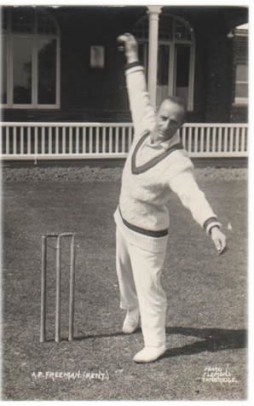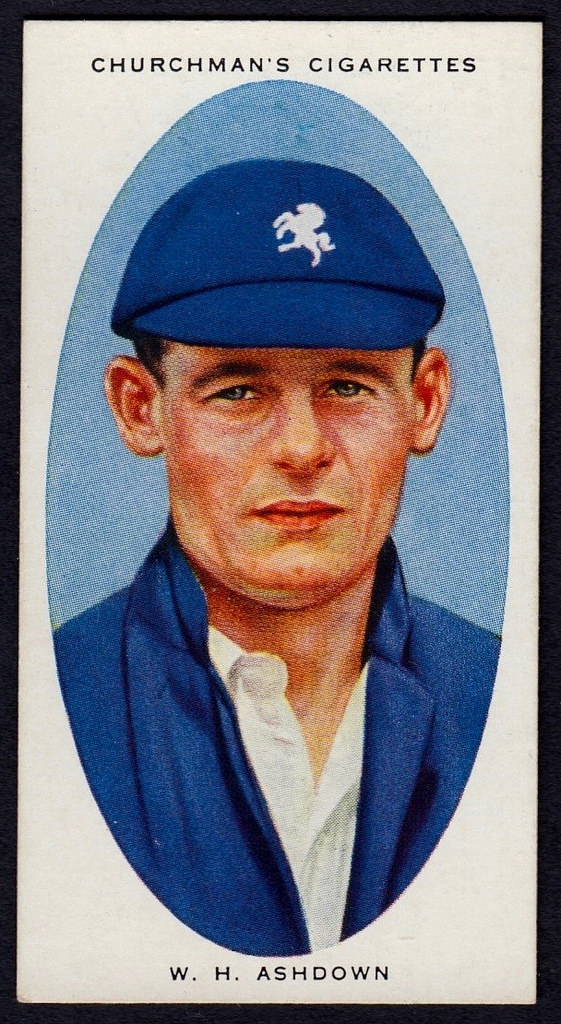Continuing the history of the club, based on the original article written by the Hon. Curator of Kent CCC, David Robertson.
The First World War took its toll of Kent players, with twelve losing their lives whilst serving their country. Most notable among them were Colin Blythe who took more than 2,500 wickets, and Kenneth Hutchings who scored in excess of 18,000 runs. The names of those twelve casualties, together with the thirteen who died on active service in World War Two, are commemorated on the Colin Blythe Memorial which has stood for many years in the St. Lawrence Ground in Canterbury, and which, after a refurbishment, will be rededicated later this year.
Inevitably, the loss of those players, and the retirement of others which the war had undoubtedly deprived of further success, meant that Kent was not going to enjoy the dominance of pre-war days. However, in the first post-war season of 1919, the title almost came back to the County, with all depending on Kent winning their final match. However, it ended in a draw, with Middlesex defending stubbornly being just 16 runs ahead with 9 wickets down. So the title went to Yorkshire, with Kent having to settle for the runner-up spot. For this first season following the war matches were of only two days duration and only once was the side beaten in the 14 matches played.
In the season immediately prior to the war, Kent introduced to the side A.P. “Tich” Freeman, who was to become a legendary figure in the inter-war years. He was another product of the Tonbridge nursery and made his debut at the relatively advanced age of 26. He went on to serve the County for 22 years, not retiring until 1936 at the age of 48. Before joining Kent he played in several Club and Ground matches for Essex, who decided not to engage him! From 1920 onwards he took in excess of 100 wickets in every season with his leg breaks and googlies. For seven years in succession, from 1929, he took more than 200 wickets per season, and in 1928 he reached the 300 wicket mark (finishing with 304 in the season), the only bowler ever to have achieved that remarkable feat. This is surely a record that will never be equalled. He is the second greatest wicket-taker that county cricket has ever known, after only Wilfred Rhodes of Yorkshire. In all he took 3340 wickets for Kent, and took ten wickets in a match 128 times, exactly twice as often as the next man, Colin Blythe. Despite his outstanding record for Kent, he played in only 12 Test Matches. The new retirement apartments along the Old Dover Road at Canterbury have been named Freeman House in his honour.

That the County’s record in the years between the wars did not bring any rewards in terms of the Championship was due to the side’s refusal to turn down a challenge. Their reputation for exciting and entertaining cricket meant that many matches which could well have been drawn, were lost. Throughout those years the team won 258 of the 563 Championship matches played, but 150 were lost, many when the side was chasing a target. But it could not be claimed with any justification that the batsmen let the side down, for in those years between the wars there were 377 centuries scored (an average of almost 19 a season) with Woolley contributing 96, “Wally” Hardinge 52, and Leslie Ames 50.
Although there were no Championship successes, the County produced more than a few players who won international recognition. “Tich” Freeman and Frank Woolley have already been mentioned, but there were many others. Leslie Ames, reckoned to be one of the finest ever wicket-keeper batsmen, and one of a trio of Kent players to have scored a century of centuries; A.P.F. (Percy) Chapman, an adventurous left-handed batsman and outstanding fielder who played in 26 Test Matches and captained England on 17 occasions during which he led the side to recapturing the Ashes in 1926; Arthur Fagg, the only batsman to have scored two double hundreds in the same match, and whose career spanned the pre and post-war years; Bryan Valentine who toured India and South Africa in the 1930s, playing in seven Test Matches and finishing with a Test batting average of 64.85; Doug Wright, a brilliant leg-break bowler whose Test career covered the periods before and after World War 2; and Geoffrey Legge who scored 196 for England against New Zealand in Auckland in 1929/30 and captained Kent for three years, 1928-1930.
These, and many others, entertained large crowds throughout those years. Bill Ashdown, who scored more than 1,000 runs in every season except one between 1926-1939 and who scored the only two triple hundreds ever made for Kent, was also a pretty good all-rounder, taking 595 wickets for the county. Among others who made their mark with the bat in this period was Leslie Todd who was a talented all-rounder before and after World War Two. In his 13 pre-war seasons he scored over 12,000 runs and took 498 wickets.

But it is rightly said that bowlers win matches and Kent had its fair share throughout the inter-war years and although lacking an out and out strike bowler, there was plenty of variety. Mention has already been made of “Tich” Freeman, but there were others. Charles “Father” Marriott, who made his Kent debut in 1924 and combined with Freeman to create the deadliest leg-break combination that English cricket has ever known, took five wickets in an innings on 38 occasions and ten in the match eight times, and was one of that rare breed of first-class cricketers who took more wickets for his county (463 at 20.28) than he scored runs (356 at 4.81). Doug Wright, who came onto the scene in Freeman’s and Marriott’s final years, was the third leg-spinner on the staff in the mid to late 1930s. Apart from his Test appearances he played in 125 matches for the County in the years before World War Two, taking 488 wickets at 24.45 and in two seasons exceeding 100 wickets. In 1937 he took two hat tricks and by the end of his career had added another five, to create a world record which still stands. He took five wickets in an innings 132 times and ten in a match 38 times. Other outstanding bowlers of the period were George Collins, a right-arm fast medium bowler who was also a useful batsman. He took almost 400 wickets including 16-83 against Nottinghamshire at Dover in 1922. A.C. (Charlie) Wright was also a fast medium bowler who took 598 wickets between 1921 and 1931 and who by all accounts (especially his) suffered badly from dropped catches!
During this period there was much entertaining cricket and perhaps two examples typify how Kent approached the game. Against Essex at Brentwood in 1934 Kent scored 803-4 declared, with Ashdown making 332, Ames 202 and Woolley 172. This score was achieved in 146 overs at a rate of 5.5 runs per over! Despite Essex scoring 408 in their first innings, Kent won by an innings and 192 runs. The second example is the match against Gloucestershire played at Dover in 1937. Gloucestershire had scored 434 in the first innings to which Kent’s reply was 399. Gloucestershire’s second innings score was 182, leaving Kent 219 for victory in less than two hours. The target was reached in 71 minutes, a rate of scoring of which Wisden said ‘history contains no mention of a faster scoring feat in first- class cricket.’ The total was achieved in 23.2 overs, a rate of 9.4 runs an over.
The 1938 season was Frank Woolley’s farewell. It is worth highlighting the record of the probably the finest all-round cricketer of any age. He played for 29 seasons – from 1906 to 1938 – during which he exceeded 1,000 runs 27 times and 2,000 runs in 6 of those seasons. He took more than 100 wickets in a season on 6 occasions. That was his contribution for Kent. His overall first-class record shows that he was second only to Jack Hobbs as a batsman, scoring 58,969 runs to Hobbs’ 61,237. Whilst Hobbs took just 50 wickets Woolley’s total was 2,068. He also took 1,018 catches!
To be continued…
0 Comments